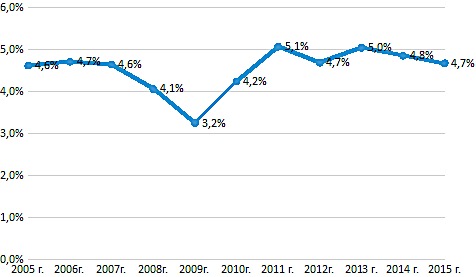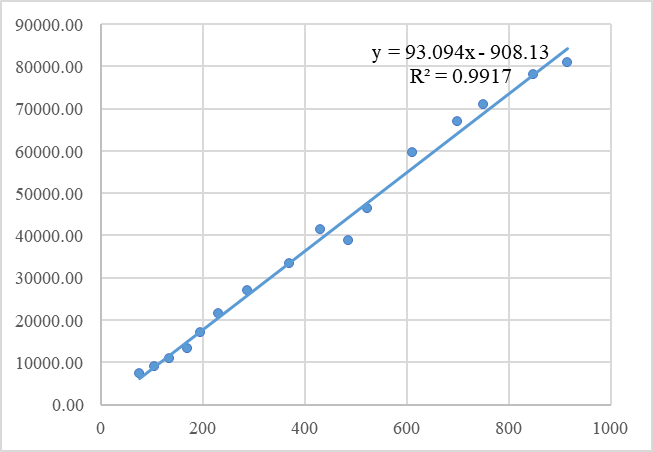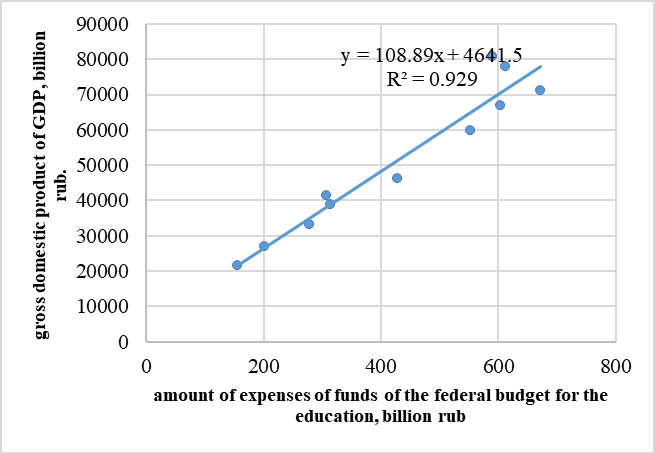Abstract
This paper investigates the level of impact of higher education on economic development, how it can help people to increase their personal income, the ways to improve the allocation of human resources, the manner of transferring knowledge and skills to other members of the society, the synergistic effect of cooperation on the basis of getting new knowledge and skills, the effect of cultural influence on law-abiding behaviour, and the impact of the development the creative abilities based on deeper comprehension of cultural achievements. The authors established that state participation in the organization and financing the education, educational service and market regulation contributes to the improvement of the positive externalities of educational impact on society. This activity of the state is confirmed by the growth of investment into human capital and the gross domestic product (GDP) in Russia from 2000-2016.
Keywords: Human capital assetscholastic investmentseconomic development
Introduction
Most researchers believe that highly developed countries provide new forms of management in higher education and high quality educational services that correspond to the needs of innovative economy development, allow to maintain a high rate of economy innovative renewal, produce high quality of manufactured products and services, ensure close cooperation among universities, business and government in the field of scientific research and of innovative activities development.
The works of Gary S. Becker (Becker, 1962) describe the early stages of the human capital asset development, the theoretical and methodological foundations of its origin and function. He introduced the division of company capital into tangible and intangible ones; explained the distribution of income over time based on theory of human capital (both the current and future value) of the different territories, and individual farms located in the same area. Earlier, Marshall in his work “Principles of Economics"(1890) argued and explained that the most significant capital forms in terms of value creation - are those which are invested in human capital. In his further research, Becker (1975) began to investigate a special group of investment in human capital asset, the category of on-the-job training. But later this group became less meaningful, in comparison with the investment in schooling, information and health service. According to the author the category of on-the-job training shows the relationship between human capital asset and income of the population of different age categories more clearly and evidently.
Theodor W. Schultz (1961) in his works compared the human resources with capital, which has a level of profitability and can be considered as an investment resource.
Considering human capital as cost category, due to the fact that any kind of capital is characterized by the value (costs), authors (Eicher & Garcia-Penalosa, 1999) studied factors forming demand and supply on the human capital asset.
Under conditions of globalization of world economic relations authors (Teixeira & Fortuna, 2003) investigated the interrelation between investments in human capital and the ability to create innovation, the costs of research and experimental development (R & D) and overall performance. As a result of the research it was found out that the increase in R & D costs by 1% results in productivity increase by 0.23%.
At the present time, the author (Goldin, 2014) considers the prospects of creation and development of human capital asset in the context of globalization. Human capital asset, in addition to physical capital, plays an important role in the creation of the expanded reproduction at the macro level. As one of the reasons for the increase and concentration of human capital asset the authors Fernandez & Mauro (2000) point out natural causes, such as an increase in birth rate that leads to change (improvement) of the demographic situation in the country. Systematization of views and trends in improvement of the quality of the educational process and its role in the development of human capital are also posited are (Hanushek, 2013).
Some researchers (Boztosun, Aksoylu & Ulucak, 2016) have studied the interdependence of human capital and GDP. They have concluded that individuals who have higher levels of education qualifications and capabilities play the main role in the increase of the competitiveness of the regions.
Scientific research institutions and organizations have carried out research in the field of scholastic investment impact on economic growth. Some researchers (Son, 2010) studied not only economic efficiency but also social efficiency of scholastic investment at the macro level, the rate of level of human capital asset achievement by the developing countries, as in industrialized countries.
Problem Statement
Modern market considers investment into human capital as an integral part of developing innovative economy and the overall growth of the national economy.
Table
Table

According to Figure
At present the Russian government has to increase the volume of financing target state educational programs in order to improve the quality of teaching, to provide competitive labour force and to create favorable investment conditions.
Research Questions
The authors estimate the efficiency of the use of budget funds invested to the educational sector, in particular, to higher education sector. Considering state investments into the educational sector, we expect a positive economic impact on the growth of GDP in Russia. The theoretical part considers the problem of the increase of the volume of the federal budget education expenditures and its compliance with the amount of the gross domestic product GDP in Russian Federation.
But, the investment process is not a one way road. State support of the national educational sector in the form of target financing is a stimulus for attracting funds of private households. So, the authors highlight the interdependence between investments of private households and the volume of GDP. This investigation is urgent because the educational system plays the main role in the field of research in the following branches of science as: biochemistry, medicine industry, petrochemistry and plastics production.
Purpose of the Study
The basic tendencies of higher education system development are caused by rising contribution of higher education in economic development. At present the process of the development of Russian educational sector coincides with the process of improvement educational service. In 2016 Russia continued improving the system of education in order to increase the efficiency of organizations that provide educational activity and to get better results from the educational sector. It led to combining educational organizations in order to decrease budget financing of the education. According to data of the Table 1the total number of higher educational organizations in 2016 compared to the year 2015 decreased by 8.8% (or by 78 units); the number of state and municipal higher educational organizations decreased by 5.3%(or by 28 units); the number of current private higher educational organizations by 13% (or by 51%). The total number of students in higher educational organizations also decreased. In comparison with 2015 their number decreased by 387.5 thousand people, the significant decrease occurred in private educational organizations (by 28.4% from the total number of students in 2015).
In an era of accelerating changes higher education generates knowledge and skills for establishing or developing innovative economy. It leads to increase in personal income of the recipient of education services, and encourages the growth of the national wealth. But besides, higher education creates a number of positive external effects for society:
economic organization of education, including higher one, contributes to the formation of knowledge, skills and practical competencies corresponding to requirement structure for work places in the system of economic activity, thus it creates a Pareto-improvements in human resources allocation (human capital asset), and therefore, as a secondary effect creates a Pareto-improvement based on the distribution of other economic resources;
by means of the distribution of knowledge and skills of effective organization of economic activity contributes to the growth of labor productivity in the society;
by means of communication and cooperation forms the synergistic effects of the application of new knowledge;
by means of creation and distribution of product, process and organizational innovations contributes to the formation of new needs, thus creating additional incentives for economic activity;
forming the legal elements of culture makes citizens more law-abiding, reduces the cost of law enforcement;
contributes to a better understanding of the role of financial and economic institutions in society, creates additional motivation for their progressive improvement, which provides more favorable long-term conditions for economic development.
Research Methods
The methodological approach involves general scientific and specific methods. While preparing theoretical part of this paper we applied methods of deduction, induction, and dialectical method of learning, retrospective analysis. We used the following empirical approach and methods; comparative method, group method, ranging, integral evaluation, statistical method, specifically vertical and horizontal analysis, correlation and regression methods, cluster approach, program aimed and systematic methods.
Figure


Findings
Characteristics of the financial and economic organization of higher education in the Russian Federation, corresponding to the development needs of the country economy, include:
- the main criteria, performance indicators of higher education and individual educational institutions should be determined by their contribution to the implementation of the strategy of the economy and society development;
- higher educational system must comply with the most important characteristics of Russian economy according to the key goals and targets of economic development strategy;
- on the basis of accelerated development of the country and the elimination of the gap between advanced and economically underdeveloped countries in the future, the system of higher education should contribute to professional, personal, creative, social qualities of students, which will further promote Russia's strategic advantages in world economic competition;
- gaining necessary competencies by graduates, including those related to personal, creative and social qualities of students, which are crucial for the management and financing of higher education;
- fundamental and practical purposes of higher education are connected with the goal of achieving Russian strategic advantages in the economic competition with advanced countries, the development of abilities to fulfil the collective creative work, sharing entrepreneurial skills with the community, the development of cross-class and inter-group cooperation within organizations and country;
- important strategic advantages of Russia can be the basis for effective control system established on strategic planning, identification and implementation of the best ways to form the desired characteristics of the future economy and society, and the determination of rational methods of education regulation (including higher education) in the formation of these characteristics;
- focus on the general strategic goals of the state and organizations and effective collective economic activity supported and stimulated by the income distribution system, adequate expenditure of available resources, economic action participants, as well as their contribution to the final collective performance results which are used both in the field of material production and higher education;
- necessary flexibility and the efficiency of resource use in educational institutions can be ensured if the management of these organizations are given the authority for decision-making on the use of resources for the purpose of improvement education quality within the quotas shared by the Ministry of Education and Science;
- necessary flexibility and the economic efficiency of a highly qualified human capital asset use can be achieved on the basis of market development of skilled labour, which is currently narrowed down and restricted under the influence of monopolistic practices in the commodity, resource and money markets. It is possible to overcome the constraints and the skilled labour market disequilibrium and thus to provide an additional flow of financial resources in the field of higher education on the basis of the development of a strategic plan for economic development and in its composition - a strategic human resources training plan, complying with modernization needs, re-industrialization of the economy, the subsequent formation of the innovative model of its development.
Let us now consider which trends are formed on the Russian market of educational services in the field of educational activity funding. Expenditures of the consolidated budget of the Russian Federation in 2016 under the section "Education" is 3 058.98 billions of roubles. The biggest share of these funds accounted for the Ministry of Education and Science of the Russian Federation - 1,329,76 billions of roubles. Most of these expenditures are given for government programs and the implementation of just one program of the Russian Federation "Development of Education for 2013-2020" requires 71.85% or 1 720 ,07 billions of roubles for 2014 - 2016 years [11]. Thus, a large part of the budget funds is allocated for current funding of government programs in the field of education, rather than on the current funding of educational activities from the budget. Receipt of budget funds in the field of higher education mainly through government programs reinforces unequal distribution of budget funds among the universities.
Over the last three years both general expenditure on education and expenditure on the implementation of the main government program in the field of education declined. Federal consolidated budget provided 486.3 billions of roubles for higher education in 2016, which amounts to 3% of all federal spending. The decrease of higher education funding over the last three years reflects not only the crisis in the economy, but also the general trend of the higher education financing in Russia.
If we consider the earlier periods, the trend of higher education expenditure funding developed in the following way: in the years 2003 - 2009 the share of expenditure on higher education in relation to GDP increased, and then began to fall (Table
Conclusion
Based on our research we argue that Russia needs the following characteristics of the financial and economic organization of higher education, corresponding to the development country economy:
- the success of individual educational institutions should be determined by their contribution to the implementation of the strategy of the economy and society development;
- higher education system must comply with the most important characteristics of Russian economy;
- the system of higher education should promote the best professional, personal, creative and social qualities of students;
- the system of higher education should provide necessary competencies of graduates;
-the development of students’ abilities to implement cross-class and inter-group cooperation;
- effective control system should be based on strategic planning, identification and implementation of the best ways to form the desired characteristics of the future economy and society, and the determination of rational methods of education participation (including higher education) ;
- focus on the income distribution system, adequate with expenditures of appropriate resources, economic action participants, as well as their contribution to the final results;
- the management of higher education institutions are given the authority for decision-making on the use of resources for the purpose of improvement education quality within the quotas shared by the Ministry of Education and Science;
- provision of additional flow of financial resources to the field of higher education on the basis of the development of a strategic plan for economic development and in its composition.
Common social objectives for the economy include the individual and his needs; it is quite compatible with the market requiring deeper focus on effective demand. The education system provides training of specialists who will meet the requirements of a market economy and social needs of carriers of human capital. Practice-focused training corresponds to the needs of the economy and the economic and social needs of the trainees themselves. If predatory use of human capital is limited then social needs of trainees will be more consistently and intensively work on the development of economy, improvement of the general welfare of the population.
References
- Available on: https://pdfs.semanticscholar.org/5e0d/bba20b47d010b9444180d75b9af4b1cb75f6.pdf
- Becker, G.S. (1975). Human capital: A Theoretical and Empirical Analysis, with Special Reference to Education, Second Edition: 13-44. Retrieved from: http://www.nber.org/chapters/c3733.pdf
- Boztosun, D., Aksoylu, S. & Ulucak, Z.S. (2016). The Role of Human Capital in Economic Growth. Economics World. May-June 2016, 4(3), 101-110.
- Eicher, T. & Garcia-Penalosa, C. (1999). Inequality and Growth: The Dual Role of Human Capital in Development. November, 1999, 29.
- Fernandez, E. & Mauro, P. (2000). The Role of Human Capital in Economic Growth: The Case of Spain. International Monetary Fund. Research Department. January, 2000: 27. Available on:https://www.imf.org/external/pubs/ft/wp/2000/wp0008.pdf
- Goldin, C. (2014). Human capital. Handbook of Cliometrics. Springer-Verlag.: 42. Available on:http://scholar.harvard.edu/files/goldin/files/human_capital_handbook_of_cliometrics_0.pdf
- Hanushek, E. (2013). Economic Growth in Developing Countries: The Role of Human Capital. Stanford University. April, 2013: 30. Retrieved from https://hanushek.stanford.edu/sites/default/files/publications/Education%20and%20Economic%20Growth.pdf
- Report of the Ministry of Education and Science of the Russian Federation: The official website. Electronic resource. Access: http://fin.edu.ru/InfoPanel/min_obr1.html. Accessed date 22.11.2016.
- Retrieved from: http://www.davidpublisher.org/Public/uploads/Contribute/5728113f6c88a.pdf
- Schuitz, T.W. (1961). Investment in Human Capital. The American Economic Review, 51(1), 1-17. Retrieved from http://la.utexas.edu/users/hcleaver/330T/350kPEESchultzInvestmentHumanCapital.pdf
- Son, H.H. (2010). Human Capital Development. Asian Development Bank. October, 2010 (225). ADB Economics working Paper Series: 36. Retrieved from https://www.adb.org/sites/default/files/publication/28427/economics-wp225.pdf
- Teixeira, A. & Fortuna, N. (2003). Human Capital, Innovation Capability and Economic Growth. Portugal, 1960-2001. FEP Working Paper (131), July 2003: 26. Retrieved from http://wps.fep.up.pt/wps/wp131.pdf
Copyright information

This work is licensed under a Creative Commons Attribution-NonCommercial-NoDerivatives 4.0 International License.
About this article
Publication Date
29 November 2017
Article Doi
eBook ISBN
978-1-80296-031-0
Publisher
Future Academy
Volume
32
Print ISBN (optional)
-
Edition Number
1st Edition
Pages
1-200
Subjects
Sociolinguistics, linguistics, family psychology, child psychology, developmental psychology
Cite this article as:
Laptev, S. V., Kookueva, V. V., & Tsertseil, J. S. (2017). The Role Of Investment In Human Capital In Economic Development. In Z. Bekirogullari, M. Y. Minas, & R. X. Thambusamy (Eds.), Cognitive - Social, and Behavioural Sciences - icCSBs 2017, October, vol 32. European Proceedings of Social and Behavioural Sciences (pp. 163-172). Future Academy. https://doi.org/10.15405/epsbs.2017.11.16
